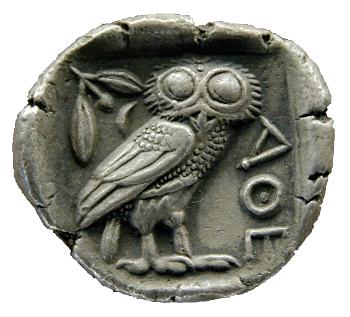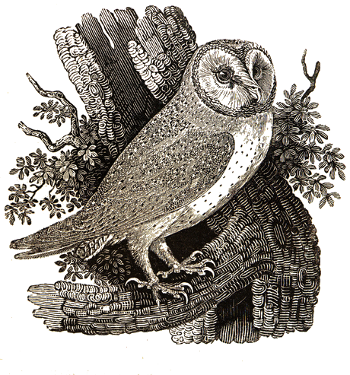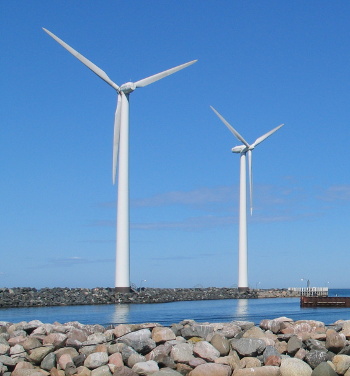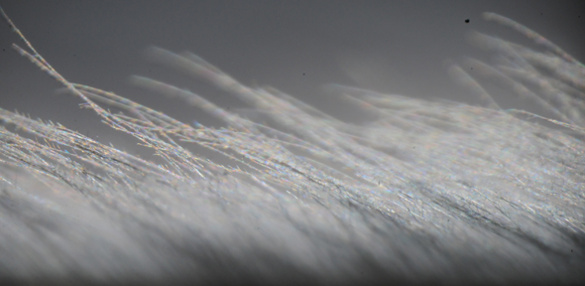Owls and Stealthy Wind Turbines
July 23, 2015
Bell, Book and Candle (1958,
Richard Quine, Director) is one of my favorite
classic films.[1] Among its cast of many
stars is
Kim Novak, who plays a modern
witch assisted in her
magic by her "
familiar," a
cat named,
Pyewacket. The
idea of a familiar is not recent. It goes back to
Greek mythology, where the
goddess,
Athena, was often accompanied by a small
owl of the species,
Athene noctua (see figure).

Athena's owl, as pictured on a tetradrachm, a four drachma silver coin, ca. 480-420 BC.
These coins were known colloquially as glaukes (γλαυκες, owls)
(Photo by Marie-Lan Nguyen, via Wikimedia Commons.)
Since Athena was the goddess of
wisdom,
mathematics,
arts, and
crafts, the owl is even today associated with wisdom, as in the expression, "
A wise old owl." The reason for the pairing of Athena and an owl is not known. What is known is the importance of
birds in the
culture of
ancient Greece, as exemplified by the
Aristophanes play, "
The Birds (414 BC)."
Athena's owl is a member of the
true owls, one of the two
families of owl, the
barn owl being the other. Barn owls are successful hunters of
barnyard pests, such as
rodents. It's strange to think that such a creature, ill-shaped for
flight, could ever catch a rapid rodent. These large birds, however, make little
noise while swooping down to capture their
prey. An understanding of how they can fly in near silence may have application to reducing noise from
wind turbines.[2-3]

A barn owl of the species, Tyto alba.
These owls are also known as "church owls" and "screech owls."
(Illustration by Thomas Bewick from the History of British Birds, 1847, via Wikimedia Commons.)
Wind power is a
renewable energy technology, and that makes wind farms an attractive
investment. As wind farms have proliferated, some
side effects of wind power have been discovered. One of the most publicized is that of
bird and bat strikes, but another vexing problem is
wind power noise. The
low frequency "thump-thump"
sound of
turbine blades propagates long distances, and this has reportedly caused
sleep problems for nearby residents.[4]
In a
paper presented at the
American Institute of Aeronautics and Astronautics (AIAA)
Aeroacoustics Conference (June 22-26, 2015,
Dallas, Texas),
scientists at the
University of Cambridge,
Virginia Tech,
Lehigh University, and
Florida Atlantic University, report how they used
high resolution microscopy to observe the fine details in owl
feathers.[3] By replicating this structure, they developed a
prototype noise-reducing
coating for
wind turbine blades.[2]

Detail of a wind farm at Bønnerup Strand, Denmark.
The blades of a wind turbine periodically disturb airflow, causing turbulence to create sound, which is an amplitude modulated pressure wave.
(Photo by Dirk Goldhahn, via Wikimedia Commons.)
The
research team found that an owl's wing feathers have a
downy covering resembling a
forest canopy. Along with this fluffy canopy, the wings have a
flexible comb of evenly-spaced
bristles along their leading edge. They also have an
elastic and
porous fringe on the trailing edge. Says
Nigel Peake, a professor in the Cambridge
Department of Applied Mathematics and Theoretical Physics.
"No other bird has this sort of intricate wing structure... Much of the noise caused by a wing - whether it's attached to a bird, a planes or a fan - originates at the trailing edge where the air passing over the wing surface is turbulent. The structure of an owl's wing serves to reduce noise by smoothing the passage of air as it passes over the wing - scattering the sound so their prey can't hear them coming."[2]
The research team endeavored to
simulate this structure in a turbine blade coating. Coating blades with nothing more complicated than a
mesh material similar to a
wedding veil lowered the surface noise by as much as 30
decibel (dB).[2] They upgraded the design by
3D printing a
pattern in
plastic. They tested the pattern on a segment of a full-sized turbine blade in a
wind tunnel and found a noise reduction of 10 dB without any great affect on
aerodynamics.[2]

Microscope image of a flight surface feather of a Great Grey Owl. These feathers are unlike those of other birds. (Cambridge University photo by J. Jaworski.)
The next step, of course, would be fully-coated blades on a functioning wind turbine. While one object of the study is noise reduction at present
rotation rates, the coatings could serve to allow faster rotation below established noise limits. The increased
power from faster spin could amount to several
megawatts for an average wind farm.[2] The 2014 estimated electrical demand in the
United States was 1,415 billion
kilowatt-hours.[5] This research was
funded by the
U.S. National Science Foundation and the
U.S. Office of Naval Research.[2]
References:
- Bell, Book and Candle (1958, Richard Quine, Director) and the Internet Movie Database.
- Silent flights: How owls could help make wind turbines and planes quieter, University of Cambridge Press Release, June 22, 2015.
- Web Site of the American Institute of Aeronautics and Astronautics (AIAA) Aeroacoustics Conference, Dallas, Texas, June 22-26, 2015.
- Advantages and Challenges of Wind Energy, US Department of Energy, Office of Energy Efficiency & Renewable Energy Web Site.
- Frequently Asked Questions - How is electricity used in U.S. homes, US Energy Administration Web Site.
Permanent Link to this article
Linked Keywords: Bell, Book and Candle; Richard Quine; classic; film; movie star; Kim Novak; witchcraft; witch; magic; familiar spirit; cat; Pyewacket; idea; Greek; mythology; goddess; Athena; true owl; owl; little owl; Athene noctua; owl of Athena; Athena's owl; tetradrachm; Greek drachma; silver; coin; colloquialism; colloquial; Wikimedia Commons; wisdom; mathematics; art; craft; wise old owl; bird; culture; ancient Greece; Aristophanes; The Birds (414 BC); family; barn owl; barnyard; pest; rodent; flight; noise; predation; prey; wind turbine; species; Tyto alba; wind power; renewable energy; technology; investment; environmental impact of wind power; side effects of wind power; bird and bat strikes; wind power noise; low frequency; sound; turbine blade; sleep; academic publishing; paper; American Institute of Aeronautics and Astronautics; Aeroacoustics; Conference; Dallas, Texas; scientist; University of Cambridge; Virginia Tech; Lehigh University; Florida Atlantic University; image resolution; high resolution; microscope; microscopy; feather; prototype; coating; wind turbine; wind farm; Bønnerup Strand, Denmark; airflow; turbulence; amplitude modulated; P-wave; pressure wave; research; down feather; downy; forest canopy; deflection; flexible; comb; bristle; elasticity; elastic; porosity; porous; Nigel Peake; Department of Applied Mathematics and Theoretical Physics; airplane; mechanical fan; scattering; simulation; simulate; mesh; material; wedding veil; decibel; 3D printing; pattern; plastic; wind tunnel; aerodynamics; Great Grey Owl; J. Jaworski; rotation rate; electric power; megawatt; United States; kilowatt-hour; funding of science; funded; U.S. National Science Foundation; U.S. Office of Naval Research; Bell, Book and Candle (1958, Richard Quine, Director).